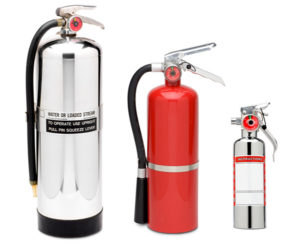
Choose the right extinguisher for your situation.
Fire extinguishers can be an effective tool, but only when you select the correct type for your needs; install them in the most effective locations; and learn the proper way to use them. This three-part series covers the basics of fire extinguishers.
Part 1 of 3 –
A portable fire extinguisher is an effective first line of defense in controlling small fires within your home or business. For maximum effectiveness, choose the correct extinguisher for your needs.
To select the proper fire extinguisher, first consider:
- what materials could fuel a fire
- how much of that material is available
- who will use the extinguisher
- the capacity of the extinguisher (see classifications below)
- whether chemicalsat the scene could react with the extinguishing agent
FIRE HAZARD CLASSIFICATIONS
In its NFPA 10, Standard for Portable Fire Extinguishers, the National Fire Protection Association (NFPA) identifies five primary classifications of fire hazards. Identifying these can help you select the appropriate extinguisher:
Class A – ordinary combustible materials, such as wood, cloth, paper, rubber and plastic
Class B – flammable and combustible liquids and flammable gases
Class C – energized electrical equipment
Class D – combustible metals, such as potassium, sodium and magnesium
Class K – cooking greases and fats
Class A, B and C extinguishers are often found in homes and businesses; Class D, in factories; and Class K, in commercial kitchens. In addition to the fire hazard classification, a numerical rating measures the extinguishing potential of type A and B extinguishers. The larger the number, in general, the larger the fire or fuel load the extinguisher can accommodate. You select the extinguisher size based on the fuel load and hazards of the area as well as how far you must travel to reach the extinguisher.
FIRE LOAD
Consider the three types of occupancy hazard (fire load) in a building when choosing an extinguisher:
- Light hazard, with few combustibles: offices, churches, school rooms and assembly halls.
- Ordinary or moderate hazards, with combustibles in an ordinary form or small quantity: mercantile storage and displays, auto showrooms and parking garages.
- Extra or high hazard, with substantial quantities of combustibles that readily support combustion: woodworking, vehicle servicing, product display showrooms and warehouses with high-piled combustibles
SELECTING THE EXTINGUISHER TYPE
Evaluate your fire hazards to select the most suitable extinguisher. If you face more than one fire hazard, select an extinguisher that can control all hazards present while avoiding any that cannot be used in your particular situation. For example:
- Fire extinguishers intended for use on Class B and C fires can’t be used on Class A fires.
- Extinguishers may increase the fire severity when used on a fire of a different hazard type. Water‑based Class A extinguishers can’t be used on Class B fires, as the flammable liquids would float on top of the water.
- Extinguishers may injure users if used to fight fires of a different class. Water-based Class A extinguishers used on a Class C electrical fire creates a shock or electrocution hazard because of the conductivity of the water.
- Class D extinguishers, designed to control a specific metal fire, may be ineffective or may exacerbate a fire on a different metal.
- Class K extinguishers were designed to control kitchen fires. A Class A, B or C extinguisher may not be able to do the job.
With proper training, selection and placement, fire extinguishers can be a valuable asset in a time of need.
Part 2: Correctly place fire extinguishers for optimum use
Part 3: Training: is key to correct fire extinguisher usage
This loss control information is advisory only. The author assumes no responsibility for management or control of loss control activities. Not all exposures are identified in this article.
